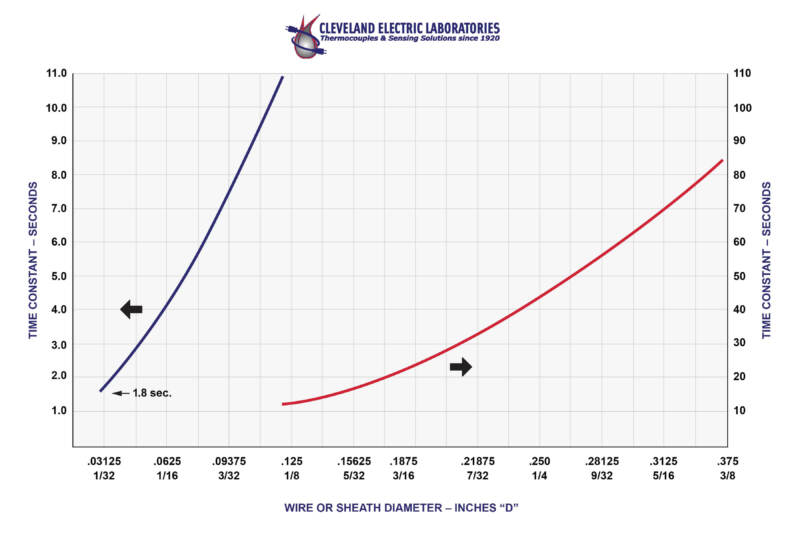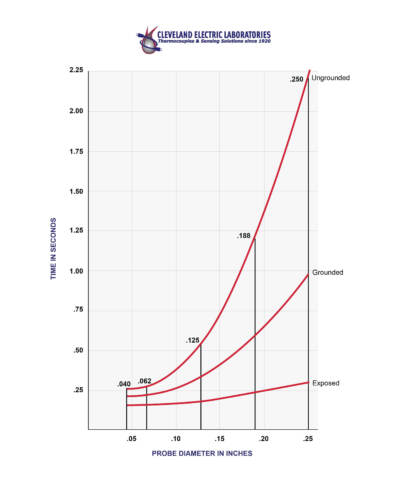Grounded vs. Ungrounded Thermocouples: What’s the Difference?
What Is a Thermocouple Time Constant?
When selecting a thermocouple for industrial use, response time is a critical—but often overlooked—performance metric. The industry-standard term for this is the “time constant.”
A thermocouple time constant is defined as the time it takes for a sensor to reach 63.2% of an instantaneous temperature change when exposed to a new thermal environment. In other words, it tells you how fast the thermocouple can react to changes in temperature, which is vital for applications where thermal conditions fluctuate quickly.
Time constants are especially useful in control systems where real-time temperature feedback is crucial for maintaining safety, efficiency, and process quality.

Understanding Grounded vs. Ungrounded Thermocouples
When it comes to thermocouple construction, the junction type—the point where the two dissimilar metals are joined—plays a major role in both response time and signal clarity. The two most common configurations are grounded and ungrounded.
Grounded Thermocouples:
In a grounded thermocouple, the measuring junction is physically attached (welded) to the inside of the protective metal sheath. This direct contact enables rapid heat transfer, resulting in faster response times. However, because the junction is electrically connected to the sheath, grounded thermocouples are more susceptible to:
- Electrical noise or EMI (electromagnetic interference)
- Ground loops, especially in systems with multiple sensors
Ungrounded Thermocouples:
In contrast, ungrounded thermocouples isolate the junction from the metal sheath using ceramic insulation or other non-conductive materials. This design eliminates electrical interference issues and is ideal for:
- High-noise industrial environments
- Applications requiring isolation from ground potential
- Systems where signal integrity is prioritized over raw speed
While ungrounded thermocouples have slower response times—typically 1.5x longer than grounded ones—they offer greater stability and noise immunity, which can be crucial in sensitive measurement systems.

How Junction Type Affects Response Time
The junction type of a thermocouple—grounded or ungrounded—directly impacts its response time, and therefore its time constant. Understanding these differences is critical when selecting a sensor for time-sensitive or high-speed applications.
Response Time Comparison:
| Junction Type | Time Constant Multiplier | Key Characteristics |
|---|---|---|
| Exposed (butt-welded) | 1x (fastest) | No sheath; direct contact with medium; minimal thermal mass |
| Grounded | ~1.1x | Junction welded to sheath; fast heat transfer, but vulnerable to EMI |
| Ungrounded | ~1.5x | Junction insulated from sheath; slower, but electrically isolated |
| Beaded Type | ~1.5x or more | Wire junction formed without sheath; typically used in lab settings |
In tests conducted in air at room temperature (65 ft/sec velocity), a bare 0.001” wire exposed junction reached 63.2% of a temperature change in just 0.003 seconds. However, when using ungrounded or beaded configurations, the thermocouple time constant increases by approximately 50%, delaying thermal feedback in fast-moving processes.
For engineers balancing speed vs. signal quality, this tradeoff should guide junction type selection. Faster isn’t always better—especially if electrical interference could skew results.
Application Scenarios: Grounded vs. Ungrounded Thermocouple Selection
Choosing between grounded vs. ungrounded thermocouples depends on your application’s specific demands for response speed, signal clarity, and electrical noise tolerance.
| Application | Recommended Type | Why It Works |
|---|---|---|
| Gas turbine testing | Grounded | Rapid response needed for real-time thermal monitoring |
| Industrial ovens or kilns | Grounded | Quick adjustments to heating cycles; typically low EMI risk |
| Glass manufacturing | Grounded or Exposed | High-speed thermal feedback critical during forming processes |
| Laboratory environments | Beaded or Exposed | High sensitivity in controlled, low-noise settings |
| Power electronics, inverters | Ungrounded | Reduces risk of ground loops and electrical interference |
| Oil & gas processing | Ungrounded | Withstands harsh, noisy environments without electrical noise interference |
| Aerospace sensors | Depends on system | Often ungrounded to prevent EMI issues in sensitive flight systems |
Factors Beyond Response Time: What Else Matters?
While thermocouple time constant is crucial, it’s only one piece of the performance puzzle. Choosing the right thermocouple also involves considering:
Electrical Noise Susceptibility
- Grounded thermocouples are more vulnerable to electromagnetic interference (EMI), especially in environments with motors, inverters, or switching devices.
- Ungrounded types reduce signal distortion by maintaining electrical isolation between the junction and sheath.

Mechanical Durability
- Grounded thermocouples tend to be more robust in high-vibration environments due to their welded construction.
- Ungrounded types, while insulated, can be more fragile depending on sheath material and mounting method.
Safety & Signal Integrity
- In systems with multiple sensors or variable ground potentials, ungrounded thermocouples prevent ground loops, reducing risk of faulty readings or equipment damage.
Selecting the Right Thermocouple with CEL
At Cleveland Electric Laboratories, we understand that no two applications are alike. Whether your process demands ultra-fast thermal response, high noise immunity, or precision in extreme environments, CEL’s engineering team is here to help you identify or custom-build the perfect thermocouple.
From high-temperature platinum assemblies to K-type sensors ready to ship, our products are backed by ISO/IEC 17025-accredited calibration, long-term durability, and decades of industry experience.



